
The South American lungfish is the single species of lungfish found in swamps and slow-moving waters of the Amazon, Paraguay, and lower Paraná River basins in South America. Notable as an obligate air-breather, it is the sole member of its family Lepidosirenidae. Relatively little is known about the South American lungfish. Additional common names include American mud-fish and scaly salamanderfish. The South American Lungfish have adapted to cope with both droughts and floods. This is normal due to the South American Lungfish adapting pulmonary mechanoreceptors. In Brazil, it is known by the indigenous language Tupi name piramboia, which means "snake-fish", and synonyms pirarucu-bóia, traíra-bóia, and caramuru.

Hymenopodidae is a family of the order Mantodea (mantises), which contains six subfamilies. Some of the species in this family mimic flowers and are found camouflaged among them; these are called flower mantises. Their coloration is aggressive mimicry, luring prey to approach close enough to be seized and eaten.
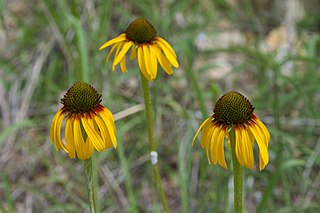
Echinacea paradoxa, the yellow coneflower or Bush's purple coneflower, is a North American species of flowering plant in the family Asteraceae. It is native to southern Missouri, Arkansas, and south-central Oklahoma, with one isolated population reported from Montgomery County in eastern Texas. It is listed as threatened in Arkansas.

Fallugia is a monotypic genus of flowering plants containing the single species Fallugia paradoxa, which is known by the common names Apache plume and póñil. This plant is native to the southwestern United States and northern Mexico, where it is found in arid habitats such as desert woodlands and scrub.

Lachnaia italica is a species of short-horned leaf beetles belonging to the family Chrysomelidae, subfamily Clytrinae.

Lachnaia is a genus of leaf beetles in the subfamily Cryptocephalinae, tribe Clytrini.
Lachnaia caprai is a species of leaf beetles from the subfamily Cryptocephalinae. It is native to Sicily.
Lachnaia orientalis is a species of leaf beetles from the subfamily Cryptocephalinae. It lives in the north of Greece.
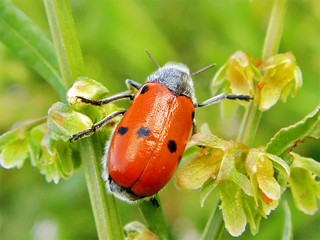
Lachnaia cylindrica is a species of leaf beetles from the subfamily Cryptocephalinae. It is found on the Iberian Peninsula and in southern France, southern Italy, on Sicily and in Algeria.
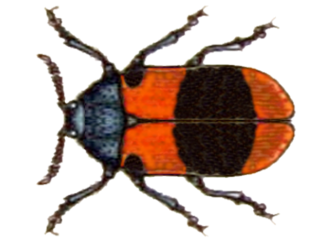
Lachnaia pseudobarathraea is a species of leaf beetles from the subfamily Cryptocephalinae. It can be found in Sierra Nevada in Spain.
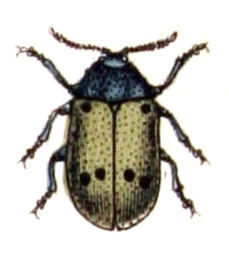
Lachnaia sexpunctata is a species of leaf beetles from the subfamily Cryptocephalinae. It is found from north-eastern France to Turkey and from north to southern Germany and Slovakia.

Lachnaia hirta is a species of leaf beetles from the subfamily Cryptocephalinae. It is found in northwest Africa, on the Iberian Peninsula and in southern France, southern Italy and on Sicily.

Lachnaia variolosa is a species of leaf beetles from the subfamily Cryptocephalinae that can be found in Algeria, Morocco and southern Spain.

Lachnaia pubescens is a species of leaf beetles from the subfamily Cryptocephalinae. It is found from North West Africa to the Iberian Peninsula, South France, Corsica and Sardinia.
Lachnaia puncticollis is a species of leaf beetles from the subfamily Cryptocephalinae that can be found in Algeria, Morocco, on the Iberian Peninsula and in southern France.

n.paradoxa: international feminist art journal was a biannual academic journal covering feminist art criticism and the work of women artists since the 1970s. It was published by KT press and the editor-in-chief was Katy Deepwell (London).

The Paradoxa Stoicorum is a work by the academic skeptic philosopher Cicero in which he attempts to explain six famous Stoic sayings that appear to go against common understanding: (1) virtue is the sole good; (2) virtue is the sole requisite for happiness; (3) all good deeds are equally virtuous and all bad deeds equally vicious; (4) all fools are mad; (5) only the wise are free, whereas all fools are enslaved; and (6) only the wise are rich.
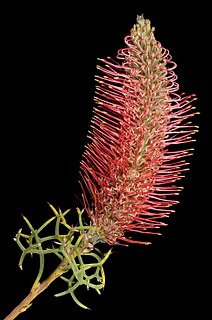
Grevillea paradoxa, commonly known as the bottlebrush grevillea, is a shrub of the genus Grevillea native to an area in the Mid West, Wheatbelt and Goldfields-Esperance regions of Western Australia.
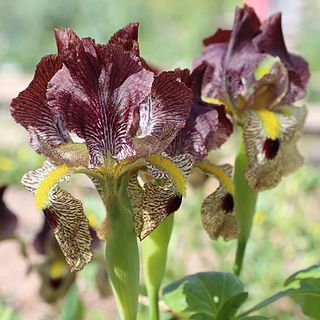
Iris paradoxa is a species of flowering plant native to western Asia. It has large upright petals and smaller lower petals, which is unique amongst most iris forms. They come in various shades from white, lavender, mauve, medium purple, violet, dark purple to black. It has a black or purplish black beard on the lower petals. It comes from the region of Transcaucasia, and is found in the countries of Iran,, Turkey, Armenia and in Azerbaijan.

Bartheletia paradoxa is a species of dimorphic fungus and is the only member of the genus Bartheletia. Bartheletia is the only genus in the family Bartheletiaceae, which is the only family in Bartheletiales, which in turn is the only order in the class Bartheletiomycetes.

















